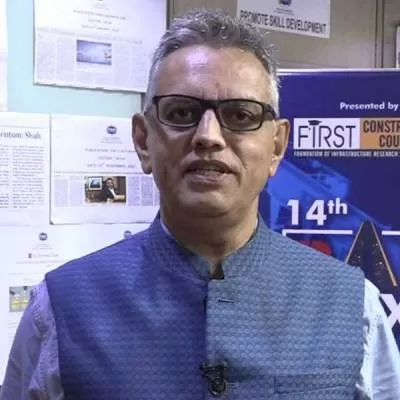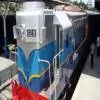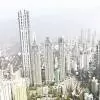- Home
- Building Material
- Formwork
- 'Form'idable Grid

'Form'idable Grid
Truth be told, the market in the past six months has not been healthy for the scaffolding and formwork industry. However, experts are hoping that sentiments will change in the coming months. ¨We expect the market to be in a better position with the Government´s focus on infrastructure,¨says Ankit Khandelwal, Country Product Manager, Doka India, ¨Better projects will be lined up in Q3 and Q4.¨
Rohitt Sharma, Group President, Maini Construction Equipments Pvt Ltd adds, ¨The current market scenario is positive with developments in infrastructure, housing and real estate.¨
Current trends
With labour scarcity all too real, the latest formwork aims to reduce manpower and improve cycle times. Adam Halliburton, General Manager, Lubeca Pty Ltd, says, ¨With labour cost increasing across the globe, the move to efficient formwork systems is essential.¨
In his view, core jump-form systems such as the Lubeca system have huge potential for India. In fact, both Lubeca and Doka jump-form systems are performing well in the market, especially for first-grade commercial and residential buildings - the Lubeca for core walls and verticals and the Dokadek 30 for slabs. System and panel slab formwork systems are also well suited to the market.
Innovative ideas
Aluminium formwork, jump-form systems and Mivan are the most popular formworks world over. As John Guest, Head EPC, Omkar Realtors & Developers, tells us, ¨Projects with heights exceeding 200 m such as the Worli 1973 and Alta Monte are being constructed with jump-forms and penalised slab systems for faster construction.¨Jump-forms reduce cycle times from 12 days (in conventional systems) to seven days, leading to major savings in tall projects. For instance, if a tower has 80 levels and five days are saved per level, a total time saving of one year is possible. Now, the Mumbai-based company plans to introduce tunnel-form technology, which is rarely used in India, for its Goregaon-based VGS (Ananta) project. This formwork reduces cycle times to three to four days, leading to major direct and indirect savings on the project cost. However, it is not suitable for super high-rise towers.
¨We are currently using Kumkang technology for our 1,000-villa project at Napa Valley in Bengaluru,¨says Nesar BS, Executive Director, Concorde Group. ¨This technology is based on aluminium formwork and used in vertical and horizontal construction. With its help, we aim to deliver an average of one villa a day.¨In this formwork, no bricks are used; only concrete. It offers superior quality and does not require plastering. Constructed the conventional way, this project would have required 2,000 labourers and taken about six to seven years to complete; now, the optimum labour required is 1,000. The total cost of this formwork with customs and additional factors is about Rs 20 crore. ¨We are also saving a lot of indirect costs such as labour cost (which is reduced by 50 per cent) and interest cost.¨
Gearing to grow
Today, the Indian market is extremely competitive, with very basic and manually intensive formwork systems competing against system formwork, often on the same job. ¨Basic formwork systems have the advantage in initial price but require much more labour,¨points out Halliburton. ¨As more system formwork is used in the industry, it will become the norm, and the more basic systems will become obsolete except on smaller and less complex projects.¨
Indeed, the formwork and scaffolding industry is expected to grow manifold. ¨India faces a huge shortfall in housing units,¨says Sharma. ¨The shortage of skilled labour and spiralling costs of labour are also a matter of concern. Hence, modern technologies have to be adopted to speed up the construction process.¨True that.
Quick Bytes
- Formwork systems can help overcome the challenge of unskilled labour and increasing labour cost.
- Demand drivers: infrastructure, housing and real estate.
- Popular picks: Aluminium formwork, jump-form systems and tunnel form technology.
Case study 1
The world´s tallest high-rise twisting tower
Project: Cayan Tower, Dubai
Architect: Skidmore, Ownings and Merrill
Developer: Cayan Real Estate Investment & Development
Contractor: Arabtec Construction LLC
Formwork supplier: MFE Formwork Technology Sdn Bhd
Formwork used: MFE Formwork Technology
Speed: Construction work cycle of each floor in six days
Cost of formwork: Approximately AED 73 million
Brief: Each floor of the Cayan Tower had to rotate 1.2¦ and achieve a full 90¦ twist at the top of the 80-storey tower. Also, the construction work cycle for each floor had to be completed in six days.
Blueprint: Owing to the twisting geometry of the Cayan Tower, the structure would have a natural tendency to undergo additional twisting movement under gravity loads, including the self-weight of the cast-in-place concrete. Hence, it was decided to proceed with MFE Formwork Technology û a revolutionary aluminium formwork system and also make use of a 3D design technology to construct this unique project. This was the only way to obtain access to details so that the specially shaped formwork panels could be manufactured accordingly.
Challenges: Upon seeing the drawings, the suppliers had three main concerns: designing the formwork for such a structure; issues that would be faced while manufacturing the formwork systems as per the strict tolerances required; and devising a work cycle to achieve the contract programme. Other major concerns involved the congestion of rebar at the main corner twisting columns and at the spandrel edge beam as these could delay the proposed six-day-per-floor construction cycle.
Solutions: With the help of the 3D technology, the supplier obtained information on the column rotation and transition and provided dimensions for both the top and bottom of each column. It helped showcase the angle of rotation at each floor correctly. The angle of the columns had to be slightly exaggerated to allow for the building settlement owing to forces of gravity and self weight of the structure and the offset angle of the sloping columns had to be increased by about 4 mm from its true shape. The concern regarding the congestion of rebar was solved as the company supplied a corner section of the building and the trial was erected at site. This was carried out two months before the formwork was used. This enabled the team to witness the angle and twist the main columns and helped them overcome any foreseen problems long before they happened on the working slab. Also, they were able to resolve any rebar congestion problems long before they appeared on site. That said, once the 3D design process was decided, manufacturing the formwork panels was not difficult. The process was carried out with +/- 0.5 tolerance as the norm. The construction work cycle was adhered to and casting of seven floors was carried out per month. Thus, Cayan Tower was completed on time and within budget.
Case study 2: India´s World Tower
Project: World Tower, Lower Parel in Mumbai
Features: Currently, two towers are under construction: World One and World Crest. On completion, World One will be over 100 stories tall and World Crest over 60 stories tall.
World One
Architect: Pei Cobb Freed & Partners
Developer: Lodha
Contractor: ACC-Simplex for World One
World Crest
Developer: Lodha
Formwork used: Lubeca jump-form system
Formwork supplier: Lubeca Pty Ltd
Cost of formwork: Cost for the verticals works out to about US$ 12 per sq m of concrete formed.
Challenges: The challenges in this project revolve mainly around the height of the buildings and the need for fast and accurate vertical formwork that is able to achieve the cycle times required, even as the height grows.
Solutions: The Lubeca jump-form system has been used for the centre core of World One and the entire vertical structure of World Crest. The World Crest system incorporated the core walls and all the perimeter columns. It also incorporated four levels of perimeter safety screens with the slab edge built in; these climbed with the core and column jump-form system. The system offers unparalleled vertical accuracy owing to its methodology for adjusting wall forms. It also requires less labour to operate and maintain. As for speed, the Lubeca jump-form has achieved cycles of under six days per floor in both applications at the World Towers site. The system is available on order in India through the Doka network.
Total formwork market (including system formwork and conventional): Rs8,000 crore.
System formwork market: Rs1,300 crore (roughly 15 per cent).
Conventional formwork leads the market with demand coming from Tier-II and Tier-III cities in India.
Opportunity in India: Around 60 skyscrapers are under construction or under approval.
- scaffolding
- formwork industry
- infrastructure industry
- Ankit Khandelwal
- Doka India
- Rohitt Sharma
- Maini Construction Equipments Pvt Ltd
- Construction
- Equipment
- Adam Halliburton
- Lubeca Pty Ltd
- India
- Commercial
- Residential
- Building
- Mivan
- John Guest
- Omkar Realtors & Developers
- Alta Monte
- Nesar BS
- Concorde Group
- Kumkang Technology
- Aluminium
- Jump Form System
- Cayan Tower
- Dubai
- Ski
The scaffolding and formwork industry is in expansion mode with the new Government focusing on the construction and infrastructure industry. Truth be told, the market in the past six months has not been healthy for the scaffolding and formwork industry. However, experts are hoping that sentiments will change in the coming months. ¨We expect the market to be in a better position with the Government´s focus on infrastructure,¨says Ankit Khandelwal, Country Product Manager, Doka India, ¨Better projects will be lined up in Q3 and Q4.¨ Rohitt Sharma, Group President, Maini Construction Equipments Pvt Ltd adds, ¨The current market scenario is positive with developments in infrastructure, housing and real estate.¨ Current trends With labour scarcity all too real, the latest formwork aims to reduce manpower and improve cycle times. Adam Halliburton, General Manager, Lubeca Pty Ltd, says, ¨With labour cost increasing across the globe, the move to efficient formwork systems is essential.¨ In his view, core jump-form systems such as the Lubeca system have huge potential for India. In fact, both Lubeca and Doka jump-form systems are performing well in the market, especially for first-grade commercial and residential buildings - the Lubeca for core walls and verticals and the Dokadek 30 for slabs. System and panel slab formwork systems are also well suited to the market. Innovative ideas Aluminium formwork, jump-form systems and Mivan are the most popular formworks world over. As John Guest, Head EPC, Omkar Realtors & Developers, tells us, ¨Projects with heights exceeding 200 m such as the Worli 1973 and Alta Monte are being constructed with jump-forms and penalised slab systems for faster construction.¨Jump-forms reduce cycle times from 12 days (in conventional systems) to seven days, leading to major savings in tall projects. For instance, if a tower has 80 levels and five days are saved per level, a total time saving of one year is possible. Now, the Mumbai-based company plans to introduce tunnel-form technology, which is rarely used in India, for its Goregaon-based VGS (Ananta) project. This formwork reduces cycle times to three to four days, leading to major direct and indirect savings on the project cost. However, it is not suitable for super high-rise towers. ¨We are currently using Kumkang technology for our 1,000-villa project at Napa Valley in Bengaluru,¨says Nesar BS, Executive Director, Concorde Group. ¨This technology is based on aluminium formwork and used in vertical and horizontal construction. With its help, we aim to deliver an average of one villa a day.¨In this formwork, no bricks are used; only concrete. It offers superior quality and does not require plastering. Constructed the conventional way, this project would have required 2,000 labourers and taken about six to seven years to complete; now, the optimum labour required is 1,000. The total cost of this formwork with customs and additional factors is about Rs 20 crore. ¨We are also saving a lot of indirect costs such as labour cost (which is reduced by 50 per cent) and interest cost.¨ Gearing to grow Today, the Indian market is extremely competitive, with very basic and manually intensive formwork systems competing against system formwork, often on the same job. ¨Basic formwork systems have the advantage in initial price but require much more labour,¨points out Halliburton. ¨As more system formwork is used in the industry, it will become the norm, and the more basic systems will become obsolete except on smaller and less complex projects.¨ Indeed, the formwork and scaffolding industry is expected to grow manifold. ¨India faces a huge shortfall in housing units,¨says Sharma. ¨The shortage of skilled labour and spiralling costs of labour are also a matter of concern. Hence, modern technologies have to be adopted to speed up the construction process.¨True that. Quick Bytes Formwork systems can help overcome the challenge of unskilled labour and increasing labour cost. Demand drivers: infrastructure, housing and real estate. Popular picks: Aluminium formwork, jump-form systems and tunnel form technology. Case study 1 The world´s tallest high-rise twisting tower Project: Cayan Tower, Dubai Architect: Skidmore, Ownings and Merrill Developer: Cayan Real Estate Investment & Development Contractor: Arabtec Construction LLC Formwork supplier: MFE Formwork Technology Sdn Bhd Formwork used: MFE Formwork Technology Speed: Construction work cycle of each floor in six days Cost of formwork: Approximately AED 73 million Brief: Each floor of the Cayan Tower had to rotate 1.2¦ and achieve a full 90¦ twist at the top of the 80-storey tower. Also, the construction work cycle for each floor had to be completed in six days. Blueprint: Owing to the twisting geometry of the Cayan Tower, the structure would have a natural tendency to undergo additional twisting movement under gravity loads, including the self-weight of the cast-in-place concrete. Hence, it was decided to proceed with MFE Formwork Technology û a revolutionary aluminium formwork system and also make use of a 3D design technology to construct this unique project. This was the only way to obtain access to details so that the specially shaped formwork panels could be manufactured accordingly. Challenges: Upon seeing the drawings, the suppliers had three main concerns: designing the formwork for such a structure; issues that would be faced while manufacturing the formwork systems as per the strict tolerances required; and devising a work cycle to achieve the contract programme. Other major concerns involved the congestion of rebar at the main corner twisting columns and at the spandrel edge beam as these could delay the proposed six-day-per-floor construction cycle. Solutions: With the help of the 3D technology, the supplier obtained information on the column rotation and transition and provided dimensions for both the top and bottom of each column. It helped showcase the angle of rotation at each floor correctly. The angle of the columns had to be slightly exaggerated to allow for the building settlement owing to forces of gravity and self weight of the structure and the offset angle of the sloping columns had to be increased by about 4 mm from its true shape. The concern regarding the congestion of rebar was solved as the company supplied a corner section of the building and the trial was erected at site. This was carried out two months before the formwork was used. This enabled the team to witness the angle and twist the main columns and helped them overcome any foreseen problems long before they happened on the working slab. Also, they were able to resolve any rebar congestion problems long before they appeared on site. That said, once the 3D design process was decided, manufacturing the formwork panels was not difficult. The process was carried out with +/- 0.5 tolerance as the norm. The construction work cycle was adhered to and casting of seven floors was carried out per month. Thus, Cayan Tower was completed on time and within budget. Case study 2: India´s World Tower Project: World Tower, Lower Parel in Mumbai Features: Currently, two towers are under construction: World One and World Crest. On completion, World One will be over 100 stories tall and World Crest over 60 stories tall. World One Architect: Pei Cobb Freed & Partners Developer: Lodha Contractor: ACC-Simplex for World One World Crest Developer: Lodha Formwork used: Lubeca jump-form system Formwork supplier: Lubeca Pty Ltd Cost of formwork: Cost for the verticals works out to about US$ 12 per sq m of concrete formed. Challenges: The challenges in this project revolve mainly around the height of the buildings and the need for fast and accurate vertical formwork that is able to achieve the cycle times required, even as the height grows. Solutions: The Lubeca jump-form system has been used for the centre core of World One and the entire vertical structure of World Crest. The World Crest system incorporated the core walls and all the perimeter columns. It also incorporated four levels of perimeter safety screens with the slab edge built in; these climbed with the core and column jump-form system. The system offers unparalleled vertical accuracy owing to its methodology for adjusting wall forms. It also requires less labour to operate and maintain. As for speed, the Lubeca jump-form has achieved cycles of under six days per floor in both applications at the World Towers site. The system is available on order in India through the Doka network. Total formwork market (including system formwork and conventional): Rs8,000 crore. System formwork market: Rs1,300 crore (roughly 15 per cent). Conventional formwork leads the market with demand coming from Tier-II and Tier-III cities in India. Opportunity in India: Around 60 skyscrapers are under construction or under approval.




















